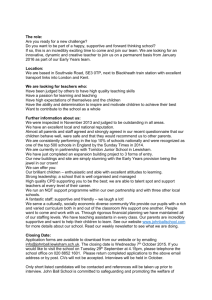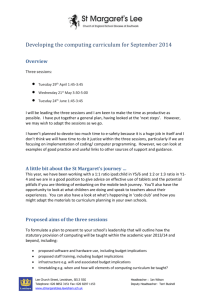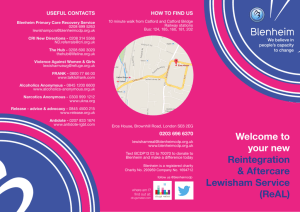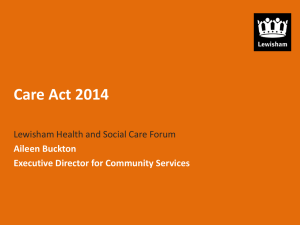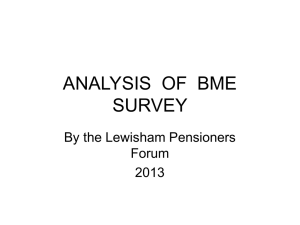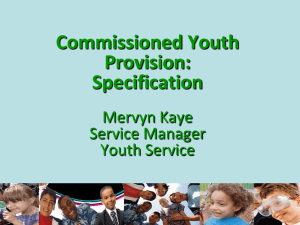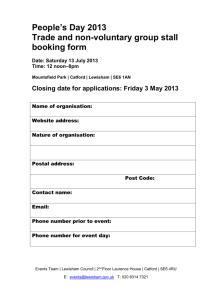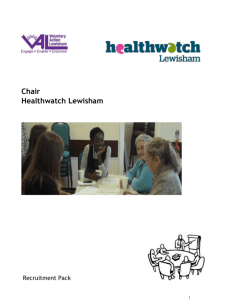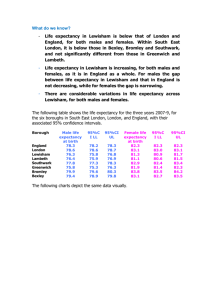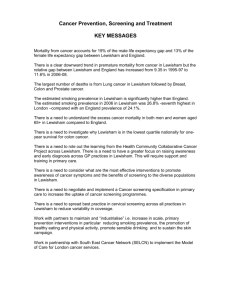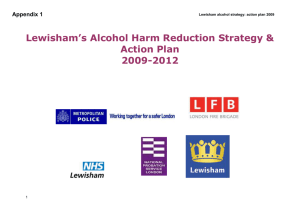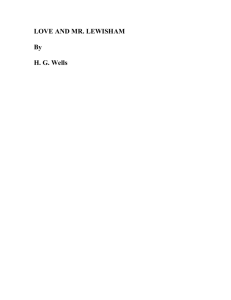1: Ideas for Reading Group Activities
advertisement
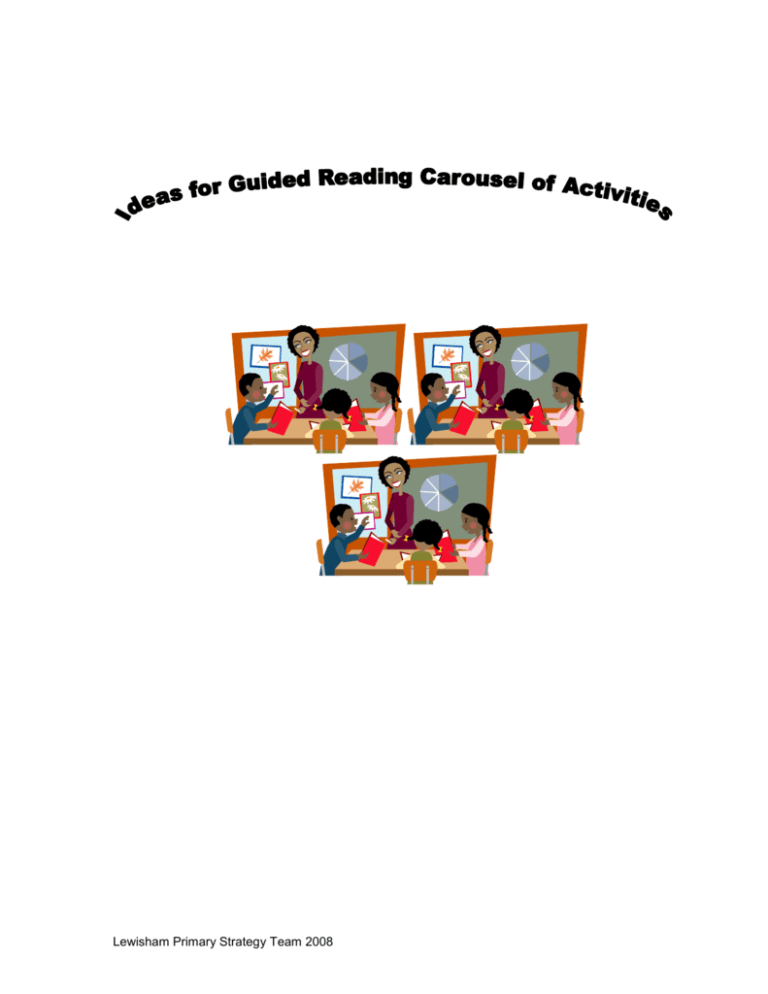
Lewisham Primary Strategy Team 2008 Ideas for Reading Carousel Activities Key Stage 2 To work as independent activities during the Guided Reading session they must be introduced and modelled so that children get the idea. You could introduce the ideas as part of introductory and plenary activities or as a quick game during your literacy sessions. Over time the children will build up their repertoire of activities that they can manage independently. CHOOSE A CONNECTIVE Give the children a sentence opener-The sad queen sat on the throne. Then challenge them to finish the sentence using a connective: after, because, before, while. (A box containing connectives could be used for this activity) SUPER SENTENCE OF THE WEEK Provide the children with a dull sentence to improve i.e. The mouse ate the cheese. Challenge the children to: 1. Add words in - The greedy mouse carefully ate the cheese. 2. Add on at the end -The mouse ate the cheese because it was hungry. 3. Add on at the beginning -While it was waiting the cat ate the cheese. 4. Change words 5. Add in a simile 6. Use alliteration SENTENCE DOCTOR Give children sentences that contain specific errors-try to feed off sorts of errors that children in your class make. The children shared there toys. ALLITERATION ALLEYProvide the children with a letter of the week and challenge them to write interesting sentences using alliteration i.e. The lazy lion led a lingering life. FINISH IT Provide the children with a box of sentence starters includingThe sun is like _________________ Challenge the children to finish the sentences using similes. Lewisham Primary Strategy Team 2008 METAPHOR MAGIC Ask the children to choose an animal and compare it to the following a number a place an object a mood a colour a number a vegetable a fruit a vehicle a T.V programme a character a plant a book For example A giraffe A A A person giraffe is like a clown on stilts. Place giraffe is like the Eiffel tower in Paris. Object giraffe is like a hat stand with no hats. LUCKILY/ UNFORTUNATELY Challenge children to write sentences which start with luckily and then unfortunately i.e. Luckily the class got a hamster. Unfortunately the hamster got lost. Luckily… Unfortunately…. PHOTOCOPY EXTRACTS FROM BOOK Children highlight key features including: Particular phonemes All of the direct speech Punctuation of a certain kind Lewisham Primary Strategy Team 2008 DICTIONARY HUNTS SPEED WRITE Children copy passages or pages from books. (Using egg timer) QUICK WRITEChallenge the children to copy words, that they frequently get wrong, as many times as they can in 1 or 2 minutes. e.g. because WORD LADDER Very useful way of developing vocabulary and improving spelling. Provide the children with a word i.e. dinosaur and challenge them to write a list of words that start with the last letter of the previous word. rabbit tiny yes sausage elephant For an extra challenge ask the children to write words linked to a particular category e.g. food Hamburger Ravioli Ice cream Moose Egg Grapes BOX OF VERBS Ask the children to choose a verb from the box and brainstorm alternative words using the thesaurus. E.g. Look Said Ate Lewisham Primary Strategy Team 2008 Amazing ABCs Challenge the children to write their own ABCs. For example: ABC of feelings ABC of boy’s names ABC of girl’s names ABC of animals. The children could then add an adjective or use alliteration, as an extra challenge e.g. The adventurous ant ate an …. The bold bear blew…. Or you could ask the children to choose a location: At the zoo… A asked for directions B built an aquarium C climbed with the monkeys HIDE AND SEEK Provide children with passages/extracts to encourage the children to start by looking for compound words then ask the children to find words that have their beginning in one word and their end in the next. Close attention = Seat NUMBER PLATES Ask the children to invent a short sentence using letters in number plates. Lewisham Primary Strategy Team 2008 Ideas for Reading Carousel Activities Key Stage 1 To work as independent activities during the guided reading session they must be introduced and modelled so that children get the idea. You could introduce the ideas as part of introductory and plenary activities or as a quick game. Over time the children will build up their repertoire of activities that they can manage independently. Character of the Week Children share books about the character of the week and write an interesting word or descriptive sentence about them (using post-its). They stick their words on the ‘Describing Word of the Week’ board. Class Post Box Children writer letters to their friends and post them in the Class Post Box. The post is delivered every morning during registration time by the Class Post Box Monitor. Spin the Word Children spin the arrow and write a sentence using the word the arrow points to. Finish the Story for Fergus Children to read the story start about the class toy frog Fergus and write an interesting ending. i.e. Fergus went to the shops… Fergus’ words of the Week Children open the frog’s mouth to discover the words of the week. Copy the words and put them into a sentence. Guess the Object Children to choose a card-read the clue and draw a picture to match e.g. I am in the garden and live in a shell. Dossie and Kwame’s Adventures 1. Children to add speech and thought bubbles to pictures of the toys getting into mischief! 2. Extend each picture into a story by encouraging the children to generate ideas for what happened before and after the action in the picture. Lewisham Primary Strategy Team 2008 Super Sentence Children to read a sentence and edit and improve it using describing words for maximum effect. Author of the Week Children share books by the author of the week. Guess the Character 1. Children to read clues on the outside of envelopes and then open them up to discover the identity of the character. (Inside envelopes children will find the name of the character with a picture to match.) 2. Children to make their own ‘Guess the Character’ envelopes. Book Bags Children explore the contents of different book bags. Book bags should include a range of activities linked to the theme of the book-including sequencing cards, story CDs, information books, story props etc. Making cards Children to make cards: SORRY, THANK YOU, HAPPY BIRTHDAY etc. Role Play Area Consider the types of reading/writing that might be found in the real world and provide them as writing formats. i.e. Restaurant menus, order forms The Clinic magazines to read, books about babies, leaflets. Sequencing Children to sequence pictures from the book of the week. ABC Children to make ABCs. These could include ABC of feelings, ABC of animals etc. Story Tent Children to share books in story tent. Reading with Teaching Assistant. Book Reviews Children to write book reviews. Book Boxes Make themed book boxes to store a small collection of books. (The boxes that photocopying paper come from are ideal.) Lewisham Primary Strategy Team 2008 New stories for old Choose an original story with a strong pattern that is easy to adapt. Children to write a new version. (You may need to model this activity through shared writing a couple of times.) i.e. We’re going on a bear hunt-We’re going on a mouse hunt. Listening Corner Children to listen to story CDs. The Chocolate Alphabet Children to make an alphabet book to stick in the wrappers from their favourite chocolate bars. Toys Story time Children to read stories to class toys. Comics Galore Children share comics (you will quickly see who enjoys this kind of reading). Ask children to bring in comics from home - many comics contain excellent examples of a wide variety of texts types, instructions for example. Comic Characters Children cut out characters from comics and label. Play dough words Children make words using play dough. Playing School Simply clip a big book that the children all know well on an easel. Arrange four or five chairs in a semi-circle. (they never need much encouragement-see who takes on the role of the adult and who joins in as the book is read.) Small World Play Provide children with story props related to the story of the week-children could re-tell the story or create their own small world. More Fluent Readers Re-write a section of the guided reading text as a comic. Reading Journals Reflecting on any aspect of the text. Reading or continuing to read the guided reading text Lewisham Primary Strategy Team 2008 Preparing for a guided reading session by reading a part of the text. Text marking Highlight evidence about the character’s feelings. Find the Word Give the children old texts/photocopies of texts/laminated pages from books and ask them to ring/highlight high frequency words i.e. and. How many can they find on a page? How many capital letters can they find? Use children’s own names as a basis for a word/letter hunt. Research- (ICT and Books) Reading other texts on the same topic or by the same author Comprehension Activities Kofi Look in Kofi’s bag and label the objects with post-its. Speech and thought bubbles Insert text into speech and thought bubbles to record thoughts and feelings. Sentence maker and alphabet puzzles. ******************************************************* Lewisham Primary Strategy Team 2008
